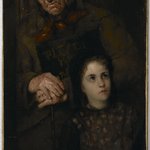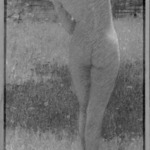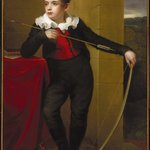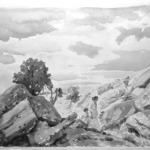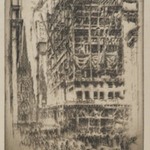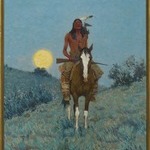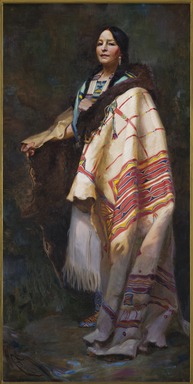
Handsome Morning -- A Dakota
Harry C. Edwards
American Art
On View: American Art Galleries, 5th Floor, From Colonies to States, 1660–1830
Harry C. Edwards’s striking studio portrait of Handsome Morning—a woman the artist identifies as Dakota Sioux—reflects a turn-of-the-century fascination with romanticized subjects in costume. Handsome Morning’s regalia consists of a fringed dress with beaded yoke, a tubular bone-bead necklace, beaded moccasins, and a buffalo-hide robe. It is likely that she was styled and posed according to conventional portrayals of Native American people made popular by the theatricalized portraits of photographer Edward S. Curtis, which included the mixing of tribal dress and ornamentation, and the use of stoic expressions and gestures.
Akin to the 1880 U.S. government–commissioned Crow Peace Delegation portraits, which were later appropriated and annotated by contemporary artist Wendy Red Star (on view nearby), Edwards’s use of his sitter’s name in the title signaled authenticity to viewers. Artists at the time were aware of the U.S. government’s long-standing exploitation of, and open assault on, the lives and lands of Native people. Edwards was likely motivated by an interest in his subject as a curiosity rather than by an active regard for her community.
Akin to the 1880 U.S. government–commissioned Crow Peace Delegation portraits, which were later appropriated and annotated by contemporary artist Wendy Red Star (on view nearby), Edwards’s use of his sitter’s name in the title signaled authenticity to viewers. Artists at the time were aware of the U.S. government’s long-standing exploitation of, and open assault on, the lives and lands of Native people. Edwards was likely motivated by an interest in his subject as a curiosity rather than by an active regard for her community.
MEDIUM
Oil on canvas
DATES
1921
DIMENSIONS
frame: 81 9/16 x 45 9/16 x 4 1/8 in. (207.2 x 115.7 x 10.5 cm)
72 1/16 x 36 1/16 in. (183 x 91.6 cm) (show scale)



SIGNATURE
Signed lower left: "c / 1921 / BY / H.C.EDWARDS"
COLLECTIONS
American Art
ACCESSION NUMBER
26.149
CREDIT LINE
Gift of the Estate of Grace C. Edwards
PROVENANCE
By 1922, gift of the artist to Grace C. Edwards of Brooklyn, NY; February 23, 1926, gift of the Estate of Grace C. Edwards to the Brooklyn Museum.
Provenance FAQ
EXHIBITIONS
MUSEUM LOCATION
This item is on view in American Art Galleries, 5th Floor, From Colonies to States, 1660–1830
CAPTION
Harry C. Edwards (American, 1868–1922). Handsome Morning -- A Dakota, 1921. Oil on canvas, frame: 81 9/16 x 45 9/16 x 4 1/8 in. (207.2 x 115.7 x 10.5 cm). Brooklyn Museum, Gift of the Estate of Grace C. Edwards, 26.149 (Photo: Brooklyn Museum, 26.149_PS20.jpg)
IMAGE
overall, Paula Abreu Pita, 26.149_PS20.jpg. Brooklyn Museum photograph, 2024
"CUR" at the beginning of an image file name means that the image was created by a curatorial staff member. These study images may be digital point-and-shoot photographs, when we don\'t yet have high-quality studio photography, or they may be scans of older negatives, slides, or photographic prints, providing historical documentation of the object.
RIGHTS STATEMENT
No known copyright restrictions
This work may be in the public domain in the United States. Works created by United States and non-United States nationals published prior to 1923 are in the public domain, subject to the terms of any applicable treaty or agreement.
You may download and use Brooklyn Museum images of this work. Please include caption information from this page and credit the Brooklyn Museum. If you need a high resolution file, please fill out our online application form (charges apply).
The Museum does not warrant that the use of this work will not infringe on the rights of third parties, such as artists or artists' heirs holding the rights to the work. It is your responsibility to determine and satisfy copyright or other use restrictions before copying, transmitting, or making other use of protected items beyond that allowed by "fair use," as such term is understood under the United States Copyright Act.
The Brooklyn Museum makes no representations or warranties with respect to the application or terms of any international agreement governing copyright protection in the United States for works created by foreign nationals.
For further information about copyright, we recommend resources at the United States Library of Congress, Cornell University, Copyright and Cultural Institutions: Guidelines for U.S. Libraries, Archives, and Museums, and Copyright Watch.
For more information about the Museum's rights project, including how rights types are assigned, please see our blog posts on copyright.
If you have any information regarding this work and rights to it, please contact copyright@brooklynmuseum.org.
RECORD COMPLETENESS
Not every record you will find here is complete. More information is available for some works than for others, and some entries have been updated more recently. Records are frequently reviewed and revised, and we welcome any additional information you might have.








